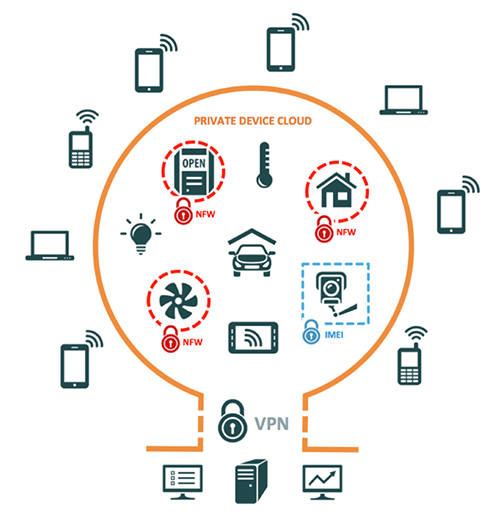The Internet of Things (IoT) is a complex, futuristic concept. While some people choose to embrace this technology and what it can do, many are still skeptical of all the modern lingo and all the talk about the IoT’s capabilities.
At the core, IoT revolves around big data. With all the horror stories circulating about cyberattacks, combined with the recent Facebook-Cambridge Analytica scandal, people are becoming increasingly wary of big data and artificial intelligence (AI) as a whole.

From an insider’s perspective, all the jargon and tech talk is simply the way of life. But for the everyday consumer, it can certainly be intimidating. That said, IoT businesses need to be able to explain their processes to customers without confusing them or scaring them away. Here are some tips to help.
Show Real-Life Applications
Laying out the actual process of the IoT is tough. In some cases, trying to explain the concept that everyday tools and services can connect with each other, harvest data based on consumption habits, and essentially manipulate everyday life can sound like the premise for a science-fiction horror film.
So, when you are explaining how the IoT works, especially to newcomers who know very little about it, you need to use plenty of real-life applications to illustrate your points. For example, if you are trying to convey how the device collects data, you could reference Ralph Lauren’s Polo Tech Shirt.

This shirt is designed to record biometric readings from athletes, such as activity levels, heart rate, breathing patterns, calories burned, etc. The goal of this IoT product is to learn about an athlete’s body and help him or her deliver the best possible performance. In what is perhaps a more widespread example, self-driving cars are IoT devices that have constant access to changing map and traffic databases to determine the best routes to destinations.
At this juncture, the IoT is still very much in the pioneering stage. For any point you are trying to make, you should always supplement it with a real-life application to put your concept in perspective.
Explain Why It Improves Everyday Life
Once you put your ideas in context, you’ve got to explain to customers the most important part: how it benefits them. Unfortunately, Hollywood has done a good job of showcasing the idea of big data, AI, machine learning, the IoT and everything of this nature as an evil entity that is hell-bent on taking over the world.
In reality, many IoT applications are designed to improve life for both individuals and businesses. For instance, companies are saving copious amounts of time and money in their HR processes by using AI-powered recruiting systems. These draw on all sorts of historical datasets to find employees who fit the exact mold of their company. Additionally, retail businesses can tap into IoT consumption habits and point-of-sale datasets to predict future trends, allocate their inventory, provide more targeted marketing strategies and more.
On the consumer side, people are using things like IoT smart plugs to make their homes more energy-efficient. Belkin’s WeMo plug is designed to monitor how much energy a home uses to set a schedule that will cut down on waste and, ultimately, save money on utilities.
Generally speaking, when you are trying to sell something, you need to make it crystal-clear how this product or service actually benefits a person’s day-to-day life. In terms of the IoT, if you can do this successfully, it will be far easier to capture customer interest and get people to approach your offerings with an open mind.
Showcase How Data Is Kept Safe
Data safety is one of the biggest concerns of the general public these days. In 2017, there were nearly 180 million records exposed as a result of data breaches. As IoT devices are constantly collecting data (sometimes very personal data), security issues will likely be one of the first things to come up.
Now, unless your target customers are IT professionals, spelling out all the technical jargon of your IoT security process might as well be a foreign language. When explaining your security measures to customers, start by opening up about the biggest threats to IoT data. Talk about the issues that are out of their control, such as malware-controlled botnets or encryption issues. Moreover, you need to be very visual in how you show customers your techniques for combatting these risks. Use diagrams, videos and infographics to illustrate these points.
Next, educate them on what they can do on their end to ensure their IoT data remains secure. This can involve creating strong passwords, protecting credentials, enabling re-authentication for more sensitive features, etc.
The key, during this part, is to speak in easy-to-understand terms that are not overly technical. Data security measures for IoT devices cannot cut any corners these days. Both businesses and customers need to be on the same page about the subject, with no gray areas.
Provide Predictions for How the IoT Will Look in the Future
The Internet of Things is in the pioneer stage of its development. If you want to sell people on these processes, you need to provide a future outlook. What are the big plans for the IoT?
For example, experts predict that there will be 10 million self-driving cars in use by 2020. Furthermore, these types of IoT-powered cars are expected to lead to 2,500 fewer deaths on the road.
Going beyond the big predictions, you should also provide insight regarding how IoT processes themselves will evolve in the years to come. Going back to the car example, most of what is out there is basic sensing technology. As time goes on, these systems will continue to gain greater control and make the concept of driving smarter and more efficient. The more you can get people excited for the future of the IoT, the easier it will be to get them onboard with what is going on right now. Think big. Be bold.
Educate Consumers on How to Stay in the Know
Hopefully by now, you’ve gotten your target customers interested and excited about the IoT and how it can improve their lives. However, the tricky part is keeping them tuned into what is happening in the rapidly evolving tech world.
Do your best to provide people with the resources necessary to keep up with the happenings of the IoT and how it impacts them. If you run an IoT business, keeping a monthly or bi-monthly blog is a great place to start. You can use this content to keep customers updated on how your process is becoming more sophisticated in improving lives, how people can use the IoT to the fullest advantage and so forth.
Given how the IoT is a relatively new concept, educating needs to be one of your primary tasks. When you are explaining IoT processes to new customers, there are going to be a lot of questions. The most important thing you can do is to phrase your language in a way that conveys the end goals in a positive light. Ultimately, this is how you get people onboard with any new type of technology. Good luck!
Mostafa Elbermawy is a seasoned SaaS growth strategist. Throughout the past nine years, Mostafa has helped brands such as American Express, P&G and Workzone refine their growth marketing strategies and tactics. Mostafa is also a regular tech contributor for Wired and BBC Arabia. He currently heads marketing at Harver, a leading AI recruitment platform.



